It’s allium season!
Of course you can have alliums most of the year but this is what’s mostly been coming out of the garden lately. Boy do they taste good! I’ve started to notice my garden is getting especially full of perennial alliums. Can you ever have too many alliums?
Now for the tour…
This is a new bed I’ve started this year, so it’s not very full yet. In the front left I have the Utrecht Onion (local version of Allium dictuon) and the right is the Amish Onion. In the middle left are a few plants of what I call Afghani Leek, because I got them from an Afghani gardener a few gardens down, but I think these are allium currat. On the right is Mc Cullar’s White Onion, that I got from Stephen (stevil) in Norway last year, and directly behind that is allium ceruum or knodding onion also from Stephen and finally in the back left are Cook’s Multiplier also from Stephen.
While we’ve been eating both the Amish Onion and the Utrecht Onion already this year, the others will have to wait a few years before we have enough to both grow and eat.
In the back of this bed is Heritage Sweet White Multiplier from Søren, but originally from Paquebot in Wisconsin. In the front are klimt shallots from Frank in Belgium, just starting to poke through the straw.
Here are the two victory onions I got several years ago from Søren. They are really great, but haven’t been multiplying very much and all we’ve been doing is eating the leaves from time to time. I’ve been growing them in tubs on our roof. I think this year I have to try moving them to the garden, and see if they do better there.
These are He Shi Ko Bunching Onion from Baker Creek. I just bought and planted these, and don’t know a lot about them.
I guess these don’t look a lot different from all the other pictures of onions here, but these are Egyptian Walking Onions. I got these from Salt Spring Seeds in Canada years ago, and they’ve been going great.
Finally, these are a few of my roughly 1000 bulbs of garlic I grow each year. I currently have about 60 varieties.
Can you tell I like onions and garlic? Does anyone have anything else I might want, and want to trade??


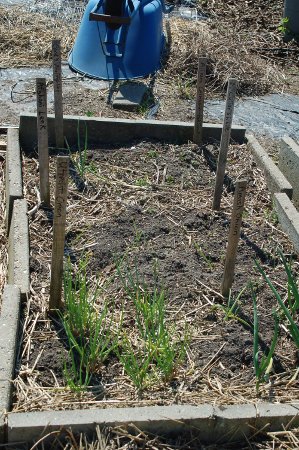
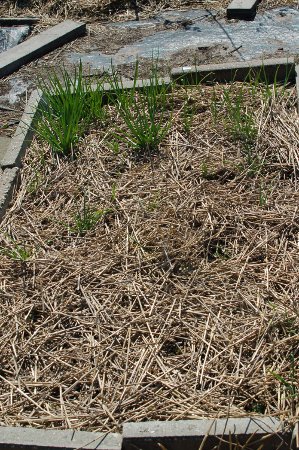
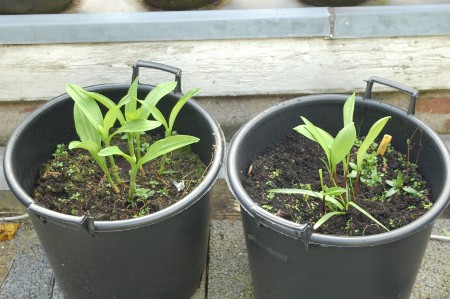
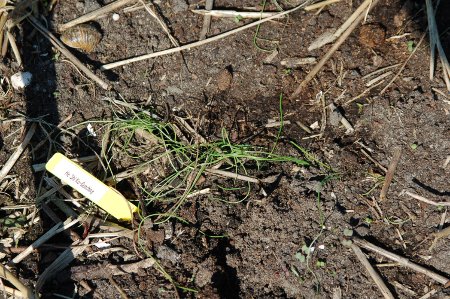
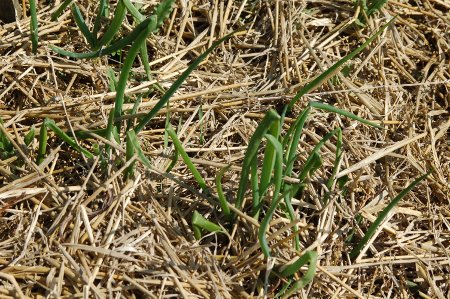
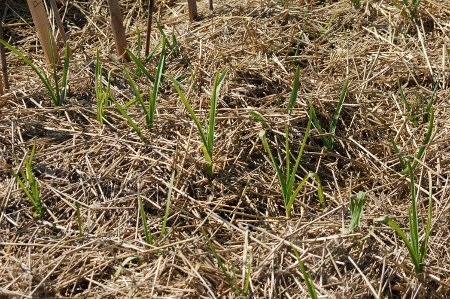
Patrick, I can tell you love garlic!
tell me one thing boy – how do you tell the diffeence between them – how do you mark them to not loose the track which one is which one.
E.
1000 garlic bulbs a year? And I thought we used a lot! I do a load at once, put it all through the blender, and freeze it ino cubes. We use several in a big potful of food.
60 varieties of garlic – I’d be in heaven. I’m currently growing only 3 varieties (Nootka Rose, Romanian Red, Ajo Rojo). All spring-planted this year, because last fall was so wet and cold.
I’m just getting started with perennial onions and learning how best to grow them. Currently have just 3 kinds – Yellow Potato Onion, White Multiplier, and Egyptian Top-Set.
Ewa: They do all taste different. You’re right, many of them look similar and I’d be in trouble if I ever lost the markers!
Entangled: I tried potato onions a few years ago, but they don’t do well in my climate. It’s too wet here I think. The klimt shallots do much better, and are similar. If you’re interested in trying some of the other things I’m growing, get in touch in the late summer or fall and I’ll send you anything I have enough extra to share.
Robert: 1000 bulbs of garlic is not as many as you might think. It’s true, if you think in terms of 365 days in a year, that’s about 3 bulbs per day, and obviously we don’t eat that much! As much as I love garlic, we normally just eat a few cloves a day.
When you plant garlic however, you always need to plant the largest cloves from the largest bulbs, meaning in the end probably only 1 bulb in 3 is suitable for planting and then probably not all of the cloves in it. This means in reality about 1/3 of my harvest has to be set aside for replanting, and the best bulbs at that. For sharing with other people, I also need to set aside larger bulbs. It’s nice to enjoy large bulbs for eating sometimes too!
The total number of bulbs I grow also has to do with the number of varieties. For example, for a few years I was growing about 100 varieties and also about 1000 in total. In this case I found that 10 bulbs of each variety just wasn’t enough. First of all a few may not grow, then I needed to select large bulbs for planting and sharing, then I needed some to eat. Only growing 10 of each just didn’t give me enough extras in case something went wrong.
I was also often facing a crisis when I discovered I was growing something very nice. At the same time I was trying to save a few extra bulbs for replanting to bulk up on it, trying to find a few extra bulbs to eat, other people were requesting it too, and having started with 10 bulbs just wasn’t enough to cope with that situation. It would end up taking me years to both bulk up on it, as well as send it to people who wanted it.
Now with 60 varieties, I’m able to grow nearly twice as many of each one, which works a lot better.
It is true, some of our garlic ends up in the compost each year too.
In terms of storing garlic, I find this isn’t necessary because we always have fresh garlic from the garden. This time of year what’s in the garden has pretty small roots, but the greens can be harvested, chopped finely, then added to foods. Also, the garlic we harvested last year, while a little sprouted, is still very edible. Starting in May, I will start to harvest ‘spring garlic’, which is about the size of spring onions. This can be chopped up like spring onions and added to foods. It tastes really good and fresh. In June the bulbs are more developed, and it can be harvested as fresh garlic. By the end of July it’s time for the normal harvest, which can also be eaten as fresh garlic until it’s cured and dried. Then we have the dried garlic to eat until the following April.
Also in June and July you can eat the scapes, which can be cooked in a similar way as green beans or made into pesto:
http://www.patnsteph.net/weblog/2007/06/garlic-scape-and-pesto/
Patrick – to the extent its possible I’d love to hear you describe the taste of the Afghani leek and the Utrecht Onion as compared to more common Allium sp.
Hi Tai Haku,
The Afghani leek, well, tastes a lot like a normal leek. The only thing is that you eat it like chives. It has very tender tops that stay small, and you can just keep cutting it back and it regrows. Eventually a flower stalk forms, and after two or three years the plant is a bit on the tough side, so it’s normally discarded at that point. Unfortunately, it hasn’t been doing well in my garden, and I haven’t been able to get any seeds.
I understand it’s eaten in many countries besides Afghanistan. For example, I understand it’s very popular in Egypt and probably other places.
The Utrecht Onion (called St. John’s Onion is some places) is something I don’t have a lot of experience with yet. I tried it once in the fall and it was hot and not nice. Now, in the spring, the bulbs we planted have divided into lots and lots of tiny spring onion like plants (this is a very prolific variety), and these spring onions are very mild, sweet and nice tasting. They are distinctly white onion flavored.
Some perennial onions have greens that are nice to eat over the course of the year, but not the Utrecht onion. The greens are usually hot and in general not interesting. So far I would say it’s only the roots that are nice to eat.
I love alliums too; I’ve got:
A. Tuberosum: Chinese Chives
A. Carinatum: my favorite – like a little leek, carefree.
A. Triquetrum: almost froze to death last winter
A. Oleraceum: purple primitive garlic
A. Paniculatum: a bit tough to the bite
A. Moly: very easy & beautiful.
A. Zebdanense: white flowers in April; looks very delicate, but grows well
Most of the above alliums have a garlic-like taste, but A. Carinatum is sweeter & almost like leek.
Warning: some alliums can become quite weedy in the garden. Eating them may help a lot.
Lieven: I forgot about your alliums! I’m going to send you an email.
No surprise that someone from Chicago likes onions.
Have you tried Allim ampeloprasum babingtonii – babington leek, grows wild on the coast in this area – I can get hold of some if you’re interested
Also Allium ursinum , ramsons/wild garlic – good leafy green early in the year. Very trendy with wild foragers and celebrity chefs. Allium triquetrum is common in hedgerows hereabouts. If any of those are of interest, let me know.
Hi Owen,
You know, until a couple of years ago when Søren explained the connection between Chicago and onions to me, I had no idea. I think in general it’s a connection totally lost by people living in the area.
Søren sent me some babington leek a few years ago, and I’m not sure what happened to it. One year it just didn’t come up. Yes, I would like to try it again. I’m also trying to germinate some seeds of A. ursinum, but not having any luck. I put them in the freezer for a month first. Any idea on how to break the dormancy?
Søren warns me this can be very invasive in the garden, have you had this experience with it?
Anyway, yes I’m interested. I’m going to send you an email.
Nice alliums. I’m all about the alliums and the brassicas this time of year. They are so sprightly, green and vigorous this time of year. I am happy to report that my A. tricocuum had no problems reappearing this year! I can’t even decide what are my favourites: the leaves, the multipliers, the topsetters. I have tonnes of babies growing in pots too. I was delightfully surprised by the taste of nodding onion A. cernuum. Have you tried it?
Hi OG,
You also have an impressive collection of alliums. No, I haven’t tried the nodding onion yet, I only got a few plants to start with and they have only been growing a couple of months. When you’re ready to take on more varieties, we’ll have to arrange a trade.
Nodding onions: I do like them too!
The one Allium I like least in the raw state is Chinese Chives. Our kids used to love these when they were toddlers – and when the plants were young too. I even had to ration their intake of Chinese Chives: otherwise the plants would never have survived 🙂